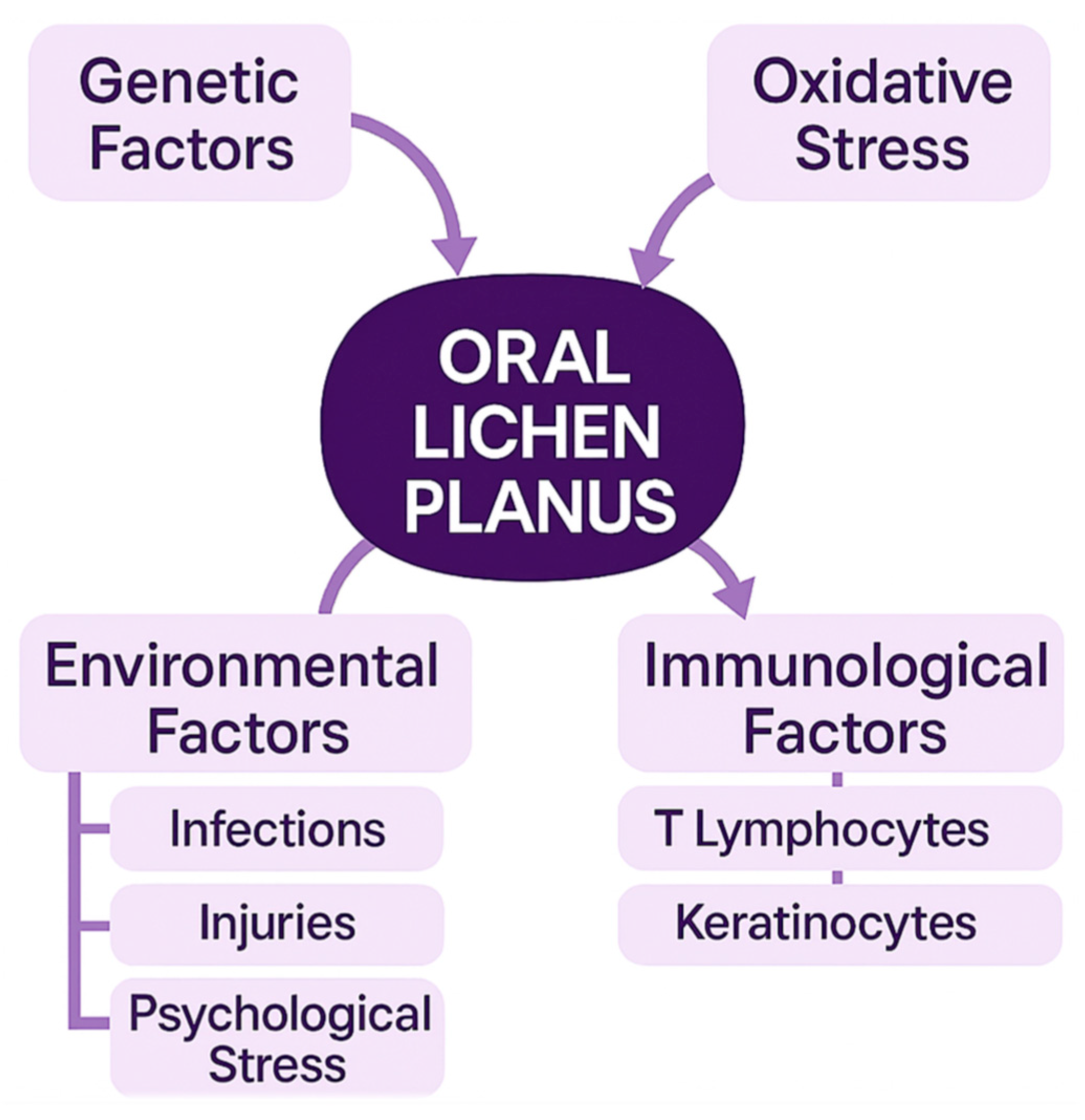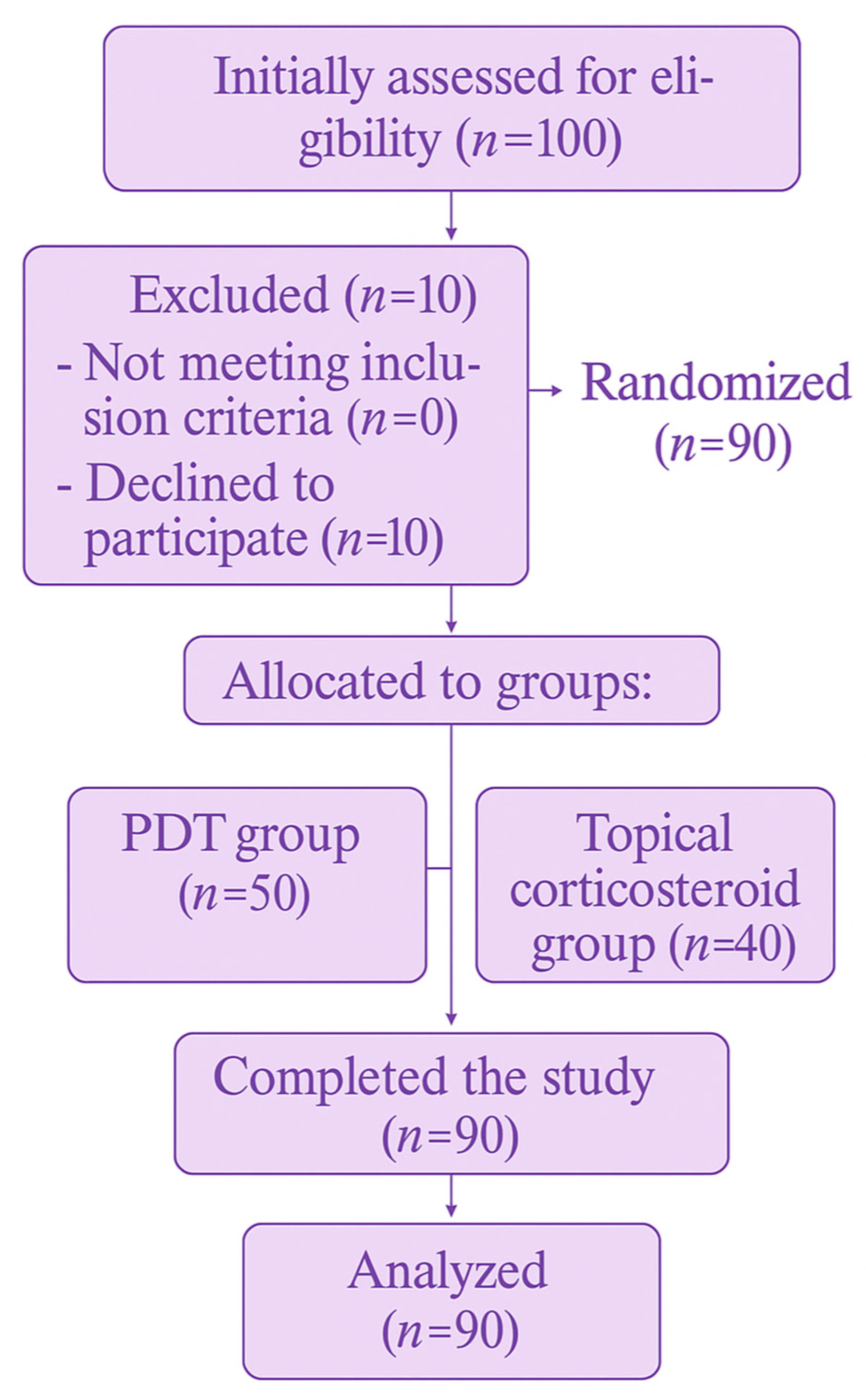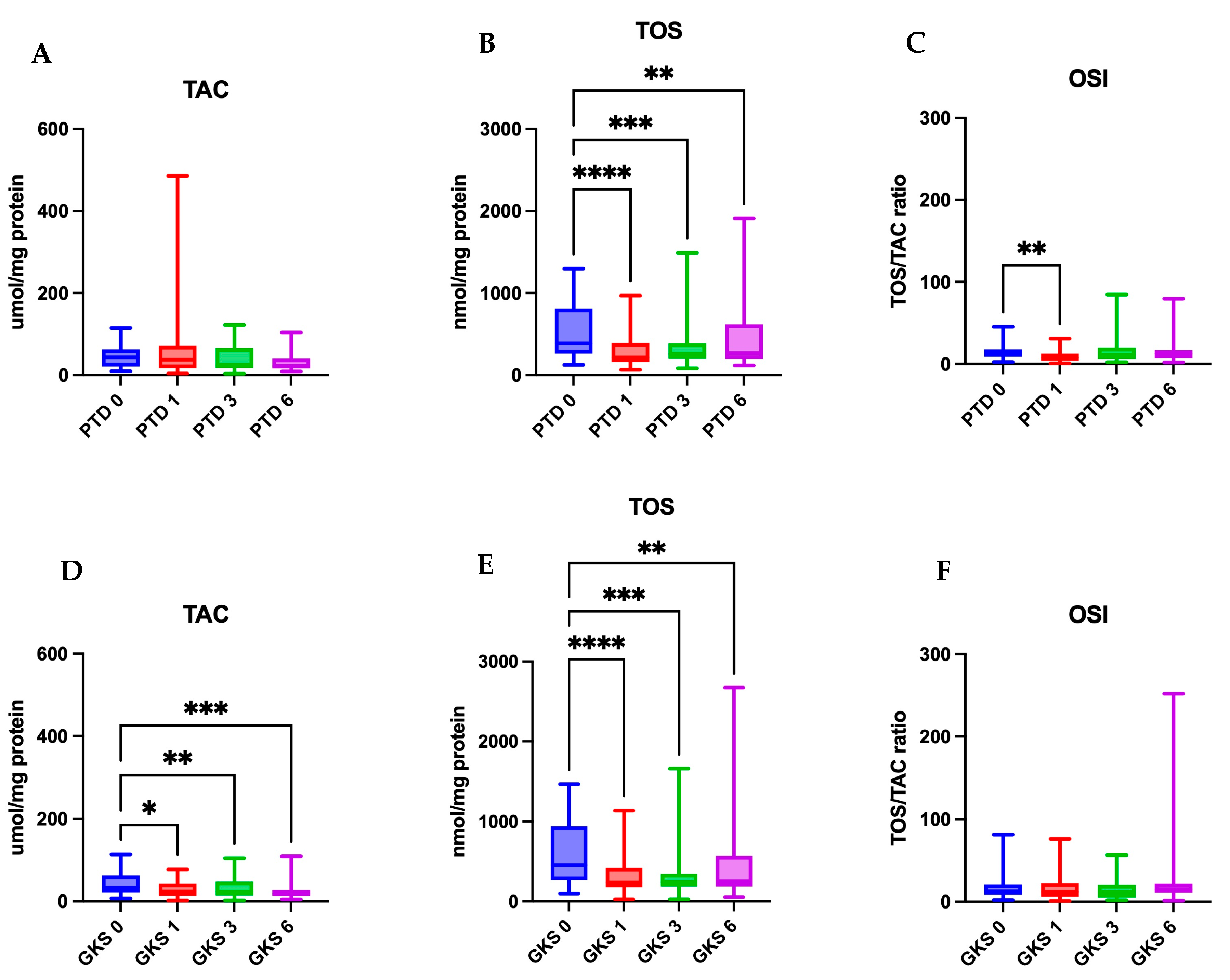Effects of Photodynamic Therapy and Glucocorticosteroids on Salivary Oxidative Stress in Oral Lichen Planus: A Randomized Clinical Trial
Abstract
1. Introduction
2. Materials and Methods
2.1. Study Participants
2.2. Study Groups
2.3. Saliva Collection
2.4. Biomarker Assays
2.5. Statistical Analysis
3. Results
3.1. Effect of PDT on TOS, TAC, and OSI Values in Saliva of Patients with OLP
3.2. Effect of GKS on TOS, TAC, and OSI Values in Saliva of Patients with OLP
3.3. Comparison of the Effect of PDT and GKS on Selected Oxidative Stress Parameters in Saliva of Patients with OLP
4. Discussion
5. Conclusions
6. Patents
Author Contributions
Funding
Institutional Review Board Statement
Informed Consent Statement
Data Availability Statement
Acknowledgments
Conflicts of Interest
References
- Warnakulasuriya, S.; Kujan, O.; Aguirre-Urizar, J.M.; Bagan, J.V.; Gonzalez-Moles, M.A.; Kerr, A.R.; Margaix, M.; Gonzalez-Ruiz, L.; Seoudi, N.; Fortune, F. Oral Potentially Malignant Disorders: A Consensus Report from an International Seminar on Nomenclature and Classification, Convened by the WHO Collaborating Centre for Oral Cancer. Oral Dis. 2021, 27, 1862–1880. [Google Scholar] [CrossRef] [PubMed]
- Li, C.; Tang, X.; Zheng, X.; Fan, Y.; Zhang, P.; Liang, J.; Yang, X.; Zhang, J.; Lu, R.; Zhou, X. Global Prevalence and Incidence Estimates of Oral Lichen Planus: A Systematic Review and Meta-analysis. JAMA Dermatol. 2020, 156, 172–181. [Google Scholar] [CrossRef] [PubMed]
- González-Moles, M.Á.; Warnakulasuriya, S.; González-Ruiz, I.; Ayén, Á.; Lenouvel, D.; Ruiz-Ávila, I.; Ramos-García, P. Worldwide Prevalence of Oral Lichen Planus: A Systematic Review and Meta-analysis. Oral Dis. 2021, 27, 813–828. [Google Scholar] [CrossRef]
- Alrashdan, M.S.; Cirillo, N.; McCullough, M. Oral Lichen Planus: A Literature Review and Update. Arch. Dermatol. Res. 2016, 308, 539–551. [Google Scholar] [CrossRef]
- Wang, Y.; Hao, Y.; Tang, F.; Chen, Q. Immune Mechanisms Involved in the Coexistence of Oral Lichen Planus and Autoimmune Thyroid Diseases. Zhejiang Da Xue Xue Bao Yi Xue Ban 2021, 50, 222–228. [Google Scholar] [CrossRef]
- Vičić, M.; Hlača, N.; Kaštelan, M.; Brajac, I.; Sotošek, V.; Prpić Massari, L. Comprehensive Insight into Lichen Planus Immunopathogenesis. Int. J. Mol. Sci. 2023, 24, 3038. [Google Scholar] [CrossRef]
- De Porras-Carrique, T.; Ramos-Garcia, P.; Aguilar-Diosdado, M.; Warnakulasuriya, S.; Gonzalez-Moles, M.A. Autoimmune Disorders in Oral Lichen Planus: A Systematic Review and Meta-analysis. Oral Dis. 2022, 29, 1382–1394. [Google Scholar] [CrossRef]
- MohanKumar, K.P.; Nachiammai, N.; Madhushankari, G.S. Association of Oral Manifestations in Ulcerative Colitis: A Pilot Study. J. Oral Maxillofac. Pathol. 2018, 22, 199–203. [Google Scholar] [CrossRef] [PubMed]
- Garcia-Pola, M.J.; Llorente-Pendas, S.; Seoane-Romero, J.M.; Berasaluce, M.J.; Garcia-Martin, J.M. Thyroid Disease and Oral Lichen Planus as Comorbidity: A Prospective Case-Control Study. Dermatology 2016, 232, 214–219. [Google Scholar] [CrossRef]
- De Porras-Carrique, T.; Gonzalez-Moles, M.A.; Warnakulasuriya, S.; Ramos-Garcia, P. Depression, Anxiety, and Stress in Oral Lichen Planus: A Systematic Review and Meta-Analysis. Clin. Oral Investig. 2022, 26, 1391–1408. [Google Scholar] [CrossRef]
- Ma, S.H.; Tai, Y.H.; Dai, Y.X.; Chang, Y.T.; Chen, T.J.; Chen, M.H. Association between Hepatitis C Virus Infection and Subsequent Chronic Inflammatory Skin Disease. J. Dermatol. 2021, 48, 1884–1891. [Google Scholar] [CrossRef]
- Lin, D.; Yang, L.; Wen, L.; Lu, H.; Chen, Q.; Wang, Z. Crosstalk between the Oral Microbiota, Mucosal Immunity, and the Epithelial Barrier Regulates Oral Mucosal Disease Pathogenesis. Mucosal Immunol. 2021, 14, 1247–1258. [Google Scholar] [CrossRef] [PubMed]
- Burton, G.J.; Jauniaux, E. Oxidative Stress. Best Pract. Res. Clin. Obstet. Gynaecol. 2011, 25, 287–299. [Google Scholar] [CrossRef]
- Wang, J.; Yang, J.; Wang, C.; Zhao, Z.; Fan, Y. Systematic Review and Meta-Analysis of Oxidative Stress and Antioxidant Markers in Oral Lichen Planus. Oxidative Med. Cell. Longev. 2021, 2021, 9914652. [Google Scholar] [CrossRef]
- Darczuk, D.; Krzysciak, W.; Vyhouskaya, P.; Kesek, B.; Galecka-Wanatowicz, D.; Lipska, W.; Kaczmarzyk, T.; Gluch-Lutwin, M.; Mordyl, B.; Chomyszyn-Gajewska, M. Salivary Oxidative Status in Patients with Oral Lichen Planus. J. Physiol. Pharmacol. 2016, 67, 885–894. [Google Scholar]
- Rezazadeh, F.; Mahdavi, D.; Fassihi, N.; Sedarat, H.; Tayebi Khorami, E.; Tabesh, A. Evaluation of the Salivary Level of Glutathione Reductase, Catalase and Free Thiol in Patients with Oral Lichen Planus. BMC Oral Health 2023, 23, 547. [Google Scholar] [CrossRef] [PubMed]
- Serafini, M.; Del Rio, D. Understanding the Association between Dietary Antioxidants, Redox Status and Disease: Is the Total Antioxidant Capacity the Right Tool? Redox Rep. 2004, 9, 145–152. [Google Scholar] [CrossRef]
- Serafini, M.; Villano, D.; Spera, G.; Pellegrini, N. Redox Molecules and Cancer Prevention: The Importance of Understanding the Role of the Antioxidant Network. Nutr. Cancer 2006, 56, 232–240. [Google Scholar] [CrossRef]
- Carrozzo, M.; Porter, S.; Mercadante, V.; Fedele, S. Oral Lichen Planus: A Disease or a Spectrum of Tissue Reactions? Types, Causes, Diagnostic Algorithms, Prognosis, Management Strategies. Periodontology 2000 2019, 80, 105–125. [Google Scholar] [CrossRef]
- Lavaee, F.; Shadmanpour, M. Comparison of the Effect of Photodynamic Therapy and Topical Corticosteroid on Oral Lichen Planus Lesions. Oral Dis. 2019, 25, 1954–1963. [Google Scholar] [CrossRef] [PubMed]
- Einarsdottir, M.J.; Bankvall, M.; Robledo-Sierra, J.; Rödström, P.-O.; Bergthorsdottir, R.; Trimpou, P.; Hasséus, B.; Ragnarsson, O. Topical Clobetasol Treatment for Oral Lichen Planus Can Cause Adrenal Insufficiency. Oral Dis. 2024, 30, 1304–1312. [Google Scholar] [CrossRef]
- Zborowski, J.; Kida, D.; Karolewicz, B.; Jurczyszyn, K.; Konopka, T. A Comparison of Photodynamic Therapy and Topical Clobetasol in Treatment of Oral Lichen Planus: A Split-Mouth Randomized Controlled Study. J. Clin. Med. 2025, 14, 681. [Google Scholar] [CrossRef] [PubMed]
- Nagi, R.; Muthukrishnan, A.; Rakesh, N. Effectiveness of Photodynamic Therapy (PDT) in the Management of Symptomatic Oral Lichen Planus—A Systematic Review. J. Oral Biol. Craniofacial Res. 2023, 13, 353–359. [Google Scholar] [CrossRef]
- Szymańska, E.; Potaś, J.; Baranowski, M.; Czarnomysy, R.; Sulewska, M.E.; Basa, A.; Pietruska, M.; Bielawski, K.; Winnicka, K. Evaluation of Oromucosal Natural Gum-Based Emulgels as Novel Strategy for Photodynamic Therapy of Oral Premalignant Lesions. Pharmaceutics 2023, 15, 2512. [Google Scholar] [CrossRef]
- Szymańska, E.; Potaś, J.; Maciejczyk, M.; Sulewska, M.E.; Pietruska, M.; Zalewska, A.; Pietruska, A.; Winnicka, K. Preliminary Assessment of Polysaccharide-Based Emulgels Containing Delta-Aminolevulinic Acid for Oral Lichen Planus Treatment. Pharmaceuticals 2023, 16, 1534. [Google Scholar] [CrossRef]
- Schulz, K.F.; Altman, D.G.; Moher, D.; CONSORT Group. CONSORT 2010 statement: Updated guidelines for reporting parallel group randomised trials. BMJ 2010, 340, c332. [Google Scholar] [CrossRef]
- González-Moles, M.Á.; Ramos-García, P. Oral Lichen Planus and Related Lesions. What Should We Accept Based on the Available Evidence? Oral Dis. 2023, 29, 2624–2637. [Google Scholar] [CrossRef]
- Kuć, J.; Szarejko, K.D.; Maciejczyk, M.; Dymicka-Piekarska, V.; Żendzian-Piotrowska, M.; Zalewska, A. Oxidative Imbalance as a Co-Player in Jaw Functional Limitations and Biopsychosocial Profile in Patients with Temporomandibular Disorder—Myofascial Pain with Referral. Front. Neurol. 2025, 15, 1509845. [Google Scholar] [CrossRef]
- Erel, O. A New Automated Colorimetric Method for Measuring Total Oxidant Status. Clin. Biochem. 2005, 38, 1103–1111. [Google Scholar] [CrossRef] [PubMed]
- Erel, O. A Novel Automated Direct Measurement Method for Total Antioxidant Capacity Using a New Generation, More Stable ABTS Radical Cation. Clin. Biochem. 2004, 37, 277–285. [Google Scholar] [CrossRef] [PubMed]
- Lodi, G.; Manfredi, M.; Mercadante, V.; Murphy, R.; Carrozzo, M. Interventions for Treating Oral Lichen Planus: Corticosteroid Therapies. Cochrane Database Syst. Rev. 2020, 2, CD001168. [Google Scholar] [CrossRef]
- McAleer, M.A.; Jakasa, I.; Stefanovic, N.; McLean, W.H.I.; Kezic, S.; Irvine, A.D. Topical Corticosteroids Normalize Both Skin and Systemic Inflammatory Markers in Infant Atopic Dermatitis. Br. J. Dermatol. 2021, 185, 153–163. [Google Scholar] [CrossRef] [PubMed]
- Waingade, M.; Medikeri, R.S.; Rathod, P. Effectiveness of Methylene Blue Photosensitizers Compared to That of Corticosteroids in the Management of Oral Lichen Planus: A Systematic Review and Meta-Analysis. J. Dent. Anesth. Pain Med. 2022, 22, 175–186. [Google Scholar] [CrossRef] [PubMed]
- Akbay, T.; Solmaz, Z.; Pekiner, F.; İpekci, H. Salivary Tissue Factor Concentration and Activity in Patients with Oral Lichen Planus. Oral Sci. Int. 2017, 14, 13–17. [Google Scholar] [CrossRef]
- Sánchez-Rodríguez, M.A.; Mendoza-Núñez, V.M. Oxidative Stress Indexes for Diagnosis of Health or Disease in Humans. Oxidative Med. Cell. Longev. 2019, 2019, 4128152. [Google Scholar] [CrossRef] [PubMed]
- Hashemy, S.I.; Gharaei, S.; Vasigh, S.; Kargozar, S.; Alirezaei, B.; Keyhani, F.J.; Amirchaghmaghi, M. Oxidative Stress Factors and C-Reactive Protein in Patients with Oral Lichen Planus before and 2 Weeks after Treatment. J. Oral Pathol. Med. 2016, 45, 35–40. [Google Scholar] [CrossRef]
- Mansourian, A.; Agha-Hosseini, F.; Kazemi, H.H.; Mortazavi, N.; Moosavi, M.S.; Beytollahi, J.; Mirzaii-Dizgah, I. Salivary Oxidative Stress in Oral Lichen Planus Treated with Triamcinolone Mouthrinse. Dent. Res. J. 2017, 14, 104–110. [Google Scholar] [CrossRef]
- Sanner, B.M.; Meder, U.; Zidek, W.; Tepel, M. Effects of Glucocorticoids on Generation of Reactive Oxygen Species in Platelets. Steroids 2002, 67, 715–719. [Google Scholar] [CrossRef]
- Zhou, G.; Xia, K.; Du, G.F.; Chen, X.M.; Xu, X.Y.; Lu, R.; Zhang, C.; Zhang, X. Activation of Nuclear Factor-Kappa B Correlates with Tumor Necrosis Factor-Alpha in Oral Lichen Planus: A Clinicopathologic Study in Atrophic-Erosive and Reticular Form. J. Oral Pathol. Med. 2009, 38, 559–564. [Google Scholar] [CrossRef]
- Schoonbroodt, S.; Piette, J. Oxidative Stress Interference with the Nuclear Factor-κB Activation Pathways. Biochem. Pharmacol. 2000, 60, 1075–1083. [Google Scholar] [CrossRef]
- Pignatelli, P.; Umme, S.; D’Antonio, D.L.; Piattelli, A.; Curia, M.C. Reactive Oxygen Species Produced by 5-Aminolevulinic Acid Photodynamic Therapy in the Treatment of Cancer. Int. J. Mol. Sci. 2023, 24, 8964. [Google Scholar] [CrossRef] [PubMed]
- Redmond, R.W.; Gamlin, J.N. A Compilation of Singlet Oxygen Yields from Biologically Relevant Molecules. Photochem. Photobiol. 1999, 70, 391–475. [Google Scholar] [CrossRef] [PubMed]
- Gollnick, S.O.; Owczarczak, B.; Maier, P. Photodynamic Therapy and Anti-Tumor Immunity. Lasers Surg. Med. 2006, 38, 509–515. [Google Scholar] [CrossRef]
- Cosgarea, R.; Pollmann, R.; Sharif, J.; Schmidt, T.; Stein, R.; Bodea, A.; Auschill, T.; Sculean, A.; Eming, R.; Greene, B.; et al. Photodynamic Therapy in Oral Lichen Planus: A Prospective Case-Controlled Pilot Study. Sci. Rep. 2020, 10, 1667. [Google Scholar] [CrossRef] [PubMed]



| Variable | N (%) |
|---|---|
| Gender | |
| Male | 18 (20%) |
| Female | 72 (80%) |
| Age | |
| Average age (M ± SD) | 60 ± 11.7 years |
| Parameter | Measure | T0 | T1 | T3 | T6 |
|---|---|---|---|---|---|
| TOS (nmol H2O2 Equiv/min/mg protein) | Median PDT | 385.1 | 214.3 | 258.9 | 269.9 |
| Mean ± SD PDT | 520.2 ± 357.8 | 294.7 ± 199.7 | 363.6 ± 289.3 | 459.1 ± 397.0 | |
| Min–Max PDT | 124.2–1296 | 62.95–969.5 | 81.57–1489 | 115.8–1911 | |
| Median GKS | 454.5 | 236.0 | 241.4 | 250.4 | |
| Mean ± SD GKS | 572.6 ± 380.5 | 331.8 ± 263.8 | 334.7 ± 309.6 | 464.7 ± 498.2 | |
| Min–Max GKS | 96.34–1464 | 26.81–1136 | 25.09–1658 | 53.48–2674 | |
| TAC (Trolox μmol/mg protein) | Median PDT | 43.17 | 37.36 | 24.37 | 22.5 |
| Mean ± SD PDT | 45.07 ± 28.3 | 52.4 ± 69.21 | 38.43 ± 30.79 | 34.72 ± 27.52 | |
| Min–Max PDT | 9.192–114.8 | 3.53–485.6 | 3.077–122.3 | 8.542–103.8 | |
| Median GKS | 33.41 | 23.63 | 23.11 | 17.51 | |
| Mean ± SD GKS | 43.92 ± 28.19 | 29.07 ± 18.47 | 31.63 ± 22.91 | 28.83 ± 27.6 | |
| Min–Max GKS | 7.488–113.6 | 2.108–77.1 | 2.056–104.9 | 4.713–109.5 | |
| OSI | Median PDT | 11.85 | 7.68 | 11.48 | 12.5 |
| Mean ± SD PDT | 14.15 ± 9.197 | 9.578 ± 7.45 | 15.81 ± 16.6 | 19.03 ± 19.32 | |
| Min–Max PDT | 2.326–45.35 | 0.681–30.86 | 2.085–84.63 | 1.865–79.6 | |
| Median GKS | 12.51 | 11.99 | 11.62 | 15.16 | |
| Mean ± SD GKS | 18.51 ± 17.18 | 16.24 ± 15.26 | 15.29 ± 13.17 | 23.97 ± 39.93 | |
| Min–Max GKS | 2.101–81.42 | 0.855–76.04 | 1.778–56.64 | 1.313–251.9 |
| Parameter | Time Point | PDT Median | GKS Median | p-Value (Mann–Whitney) |
|---|---|---|---|---|
| TOS (nmol H2O2 Equiv/min/mg protein) | T0 | 385.1 | 454.5 | ns |
| T1 | 214.3 | 236.0 | ns | |
| T3 | 258.9 | 241.4 | ns | |
| T6 | 269.9 | 250.4 | ns | |
| TAC (Trolox μmol/mg protein) | T0 | 43.17 | 33.41 | ns |
| T1 | 37.36 | 23.63 | 0.0304 | |
| T3 | 24.37 | 23.11 | ns | |
| T6 | 22.5 | 17.51 | 0.0941 (trend) | |
| OSI | T0 | 11.85 | 12.51 | ns |
| T1 | 7.68 | 11.99 | 0.0248 | |
| T3 | 11.48 | 11.62 | ns | |
| T6 | 12.5 | 15.16 | ns |
Disclaimer/Publisher’s Note: The statements, opinions and data contained in all publications are solely those of the individual author(s) and contributor(s) and not of MDPI and/or the editor(s). MDPI and/or the editor(s) disclaim responsibility for any injury to people or property resulting from any ideas, methods, instructions or products referred to in the content. |
© 2025 by the authors. Licensee MDPI, Basel, Switzerland. This article is an open access article distributed under the terms and conditions of the Creative Commons Attribution (CC BY) license (https://creativecommons.org/licenses/by/4.0/).
Share and Cite
Wiśniewski, P.; Sulewska, M.; Tomaszuk, J.; Zalewska, A.; Zięba, S.; Pietruska, A.; Szymańska, E.; Winnicka, K.; Maciejczyk, M.; Żendzian-Piotrowska, M.; et al. Effects of Photodynamic Therapy and Glucocorticosteroids on Salivary Oxidative Stress in Oral Lichen Planus: A Randomized Clinical Trial. Antioxidants 2025, 14, 1017. https://doi.org/10.3390/antiox14081017
Wiśniewski P, Sulewska M, Tomaszuk J, Zalewska A, Zięba S, Pietruska A, Szymańska E, Winnicka K, Maciejczyk M, Żendzian-Piotrowska M, et al. Effects of Photodynamic Therapy and Glucocorticosteroids on Salivary Oxidative Stress in Oral Lichen Planus: A Randomized Clinical Trial. Antioxidants. 2025; 14(8):1017. https://doi.org/10.3390/antiox14081017
Chicago/Turabian StyleWiśniewski, Patryk, Magdalena Sulewska, Jagoda Tomaszuk, Anna Zalewska, Sara Zięba, Aleksandra Pietruska, Emilia Szymańska, Katarzyna Winnicka, Mateusz Maciejczyk, Małgorzata Żendzian-Piotrowska, and et al. 2025. "Effects of Photodynamic Therapy and Glucocorticosteroids on Salivary Oxidative Stress in Oral Lichen Planus: A Randomized Clinical Trial" Antioxidants 14, no. 8: 1017. https://doi.org/10.3390/antiox14081017
APA StyleWiśniewski, P., Sulewska, M., Tomaszuk, J., Zalewska, A., Zięba, S., Pietruska, A., Szymańska, E., Winnicka, K., Maciejczyk, M., Żendzian-Piotrowska, M., & Pietruska, M. (2025). Effects of Photodynamic Therapy and Glucocorticosteroids on Salivary Oxidative Stress in Oral Lichen Planus: A Randomized Clinical Trial. Antioxidants, 14(8), 1017. https://doi.org/10.3390/antiox14081017









